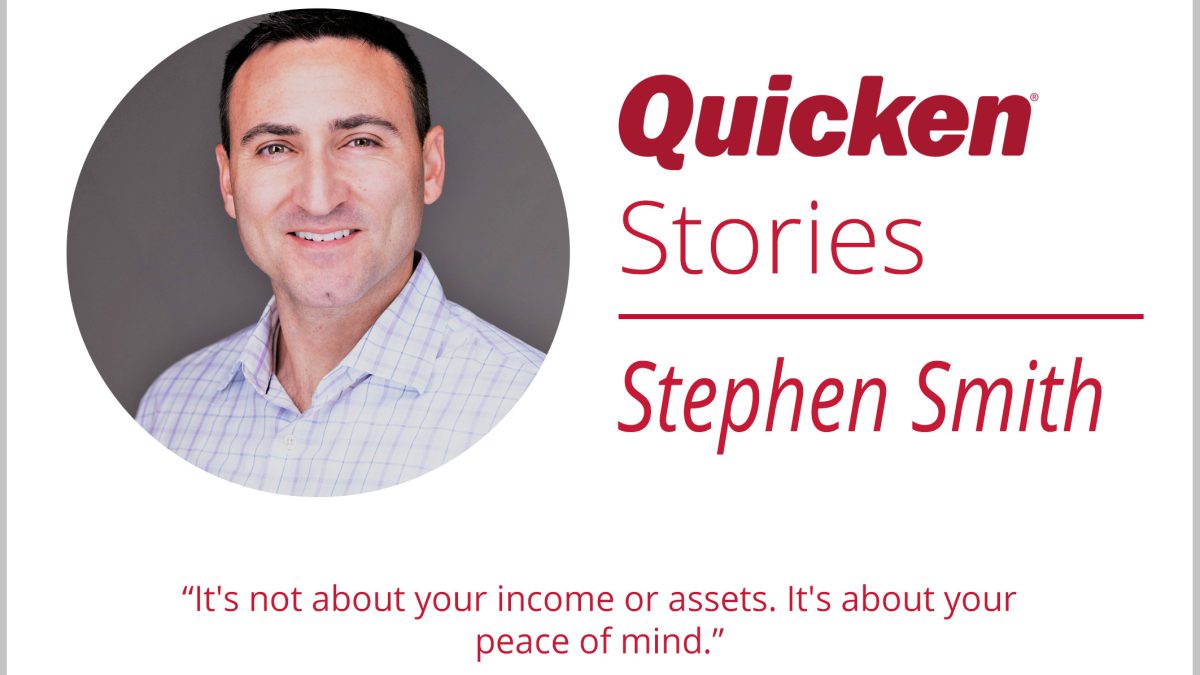Quicken Stories: Stephen Smith
Stephen Smith started using Quicken at a surprisingly young age, tracking his paper route savings as a kid and then the expenses of his first car as a teenager. Years later, when he became a CPA, his background with the software entered his professional life.
“I got a call from a potential client,” Stephen remembers, “but he didn’t really need a CPA. He needed a personal Quicken expert. He’d been using the product for years, and now he was facing a new situation. He wasn’t sure how to use the software to account for it.”
Stephen assured him that he was familiar with the software. Still, it took some convincing.
“He asked me several times if I could do it. Finally, I told him, ‘I know Quicken. I know exactly what it does. I’ve maintained my Quicken file since high school, and it’s the closest thing I have to a hobby.’ That’s what did it.”
Stephen helped him reconcile and optimize a large, complex portfolio in a single day. By day two, his new client asked him to take over and maintain it for him.
“He had depended on his Quicken data for more than a decade in making financial decisions. He needed that information. All my clients do.”
Helping Loyal Quicken Customers Navigate Life’s Milestones
Some three hundred and fifty clients later, Stephen Smith spends a significant amount of time helping long-term Quicken users navigate life’s biggest milestones.
“The typical person I help has been using Quicken for almost two decades. They all start off the same way. ‘I’ve been using Quicken for 15 years. I’ve been using Quicken for 20 years.’ And then there’s always a, ‘But, I just have this one little thing.’”
What triggers that call? It’s often retirement, but not always. It might be a real estate purchase, or their kids might be heading off to college. Usually, says Stephen, they’ve encountered some major life event, and they need a new level of control over their finances.
“‘I’ve used Quicken forever,’ they tell me. ‘Things have been going along for 10, 15 years. Now, this new thing happened, and I need to sort it out.’”
Stephen added, “They don’t need financial advice. They call me to help them optimize their Quicken file for their new situation.”
“When it comes to what they need to know, they trust the tool. They trust Quicken.”
Using Quicken to Ease the Stress of “Not Knowing”
As a long-time Quicken power-user and enthusiast, Stephen is passionate about using Quicken to help his clients—helping them alleviate the stress of major life changes—because he understands personally the value of having that financial information at his fingertips.
He used Quicken to track and carry two mortgages while he was renovating his new home. He uses it as a tax checklist at the end of every year, reconciling his 1099s to Quicken and vice versa. Because he’s self-employed, he uses Quicken Home & Business to track his accounts receivable and invoices, and he uses it to track his investments.
“I use Quicken to get a global look at asset allocation, including more than just stocks vs. equity as reported by the brokerage, but also home equity, whole-life cash values, bank accounts, retirement, and kids’ savings.”
Still, Stephen is adamant that it isn’t just about the money. It’s about having the answers he needs.
“I know I’m going to lose money when the market dips,” he explains. “I know money’s going to leave my bank account if I spend it. But not knowing how much I lost, or how much I spent at Starbucks, that would make me more anxious than the loss itself. Quicken helps me quantify those situations and put them into perspective, so I can make informed decisions.”
Families, of course, can make that problem even more complex. A client might want to add their aging parents to their own Quicken, for example, to help them manage their money, or they might manage certain assets together.
One of Stephen’s clients had bought a summer cottage with her sister, and now a lack of accurate bookkeeping and unexpected issues were adding up, threatening to come between them.
Who was paying for what? How were repairs being handled? Should they make improvements or would that stretch them all too thin?
Stephen helped them set up the cottage in Quicken so they could see what they needed to know, setting their minds at ease and avoiding unnecessary drama.
“It wasn’t the money that was the problem,” Stephen was quick to point out. “It never was. It was the stress of not knowing.”
Stephen’s Top 7 Quicken Tips
What does a professional Quicken expert recommend for getting the most out of Quicken, especially when it comes to facing new situations? Here are his top seven Quicken tips.
1. Keep your categories simple
One of the first things Stephen does is walk through his clients’ categories, helping them thin out the ones they don’t really need.
“Quicken has done a more than thorough job with their category list,” Stephen explains. “If you add a special category to track your vacation, that category will still be there six years later, accidentally pulling in new airfare costs or other similar expenses. When you have too many categories, you end up too far down in the weeds.”
2. Use tags (or #hashtags) to track unique items of interest
Instead of creating new categories to track unusual things, Stephen suggests adding your own custom tags (or #hashtags) to track your spending on those one-time events—or on anything that crosses multiple categories.
“Just like using hashtags in social media, you can hashtag a charge in the Memo field. Create custom tags like #Disney, #Wedding, #Renovation or #2020 (for those home-office expenses). You can then report on the hashtagged transactions by filtering for the hashtag.”
You can also use Quicken’s built-in tag functionality to do the same thing. Enter any custom tag name you like in the “Tag” field of any transaction in your register. (If you don’t see the Tag column, you can turn it on with the column selector. Windows instructions. Mac instructions.)
Most reports in Quicken can be filtered by tags, and you can also make global changes to your tag using the Tag list (Tools > Tag List). Editing a tag in the list will automatically update all your transactions that have that tag. Create custom tags to track your vacations, your spending on each kid, or anything else you want to.
3. Pay special attention to your transfers
When Stephen cleans up Quicken files, he often troubleshoots transfers—money that’s been moved from one account to another. He commonly discovers transfers that have been included as income or expenses even though they’re neutral events.
“If you’re paying down your credit card from your bank account, that’s not additional money you spent or made. It’s just money you moved from one place to another, decreasing the asset of your cash bank account and reducing the liability of your credit card account.”
What’s his favorite trick to handle it? “Delete the ‘Credit Card Payment’ expense category. Quicken occasionally codes credit card payments to this default category, but it’s not needed if you’re also pulling credit card activity, which most people do and everyone should.”
4. Build up from the small things
Whenever you’re reorganizing your Quicken setup, Stephen recommends testing the new structure by digging into the numbers at a detailed level. First, check the small things to make sure they look right. Then, zoom out in stages.
“Look at your grocery spending. Does that look right? Or what you spent at Home Depot yesterday. Is that showing up in home repairs? If anything doesn’t make sense, drill into it to see what’s happening.”
Once those individual transactions are in the right place, pull back to see the bigger picture.
“Check your ‘buckets’ for home services, shopping and so on. See where your Walmart and Target purchases are going. See where Amazon goes. Make sure those buckets are capturing the right things for the way you think about your finances.”
5. Track the principle and interest on your debts
When you track your debt in Quicken, make sure you’re adding that account as a debt account, entering key data like the amount you owe and your interest rate. It’s the best way to take full advantage of Quicken’s debt projection tools. Stephen also recommends setting up your loan payments as an automated bill reminder.
“If Quicken doesn’t calculate the interest expense the same way as your bank, go in and adjust the splits once a quarter or at the end of the year to keep the principal portion reconciled.” Or connect that loan account and let Quicken track the reported principal balance for you automatically.
6. Know what your net paycheck really is
If you haven’t retired yet, Stephen recommends leveraging the Gross Amount feature in the paycheck setup wizard to track your paychecks in Quicken.
“Taking the time to split out each paycheck adds to the level of accuracy of your Quicken file. You need to understand and feel comfortable with that accuracy, knowing how you go from a $100,000 salary to $60,000 in net cash. It’s extra work to edit the weekly changes, but once you build the process into your routine it gets easier over time.”
7. Keep your Quicken file up to date
Once your Quicken file is set up the way you want it, keeping those records up to date is easy if you spend just a few minutes a day—especially with automatic downloads. That way, you’ll have the answers you need when you need them.
“When it comes right down to it, most of my clients are really asking, ‘Is this okay?’ They might have 401(k)s, IRAs, and other securities. They have real estate holdings. They just want to know that it’s enough to cover the money they’re spending. They aren’t sure because their Quicken data isn’t up to speed with their new situation.”
“It’s not about your income or assets. It’s about your peace of mind.”
No matter where you are in life or how much money you have, you want to feel confident about your finances. You want to know that you’re not overdoing it—that you can cover your expenses today and still have what you’ll need down the road.
“It’s not about your income or assets. It’s about your peace of mind. Quicken provides the information and data people need to understand their financial picture. That’s what Quicken really does for people.”
Would you like to share your own Quicken story? If you’d like to participate in an interview, contact us at interviews@quicken.com. Selected stories will be featured on our blog and social media, with a special gift from the Quicken team. We’d love to hear from you!
Quicken has made the material on this blog available for informational purposes only. Use of this website constitutes agreement to our Terms of Use and Privacy Policy. Quicken does not offer advisory or brokerage services, does not recommend the purchase or sale of any particular securities or other investments, and does not offer tax advice. For any such advice, please consult a professional.
About the Author
Quicken
Our mission is to help our customers lead healthy financial lives.



